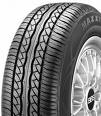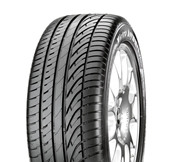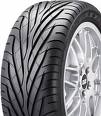Tyre Types
Tyre Patterns
1.Multi-directional
The most common pattern type is the multi-directional pattern which is not sensitive to orientation with regards to a fitting position on the vehicle. The tyre performance is equal regardless of the direction of rotation.
2. Asymmetric Tyres
AS car performance increases, tyre design has to keep pace and asymmetric patterns are becoming more common. The pattern is different either side of the centre line and tends to be more dense towards the inner edge. This leads to a better compromise between wet and dry handling.
3. Directional Tyres
A fashion originally developed for high performance cars is the directional pattern which provides optimum straight line stability and lower pattern noise generation. These patterns must be fitted the correct way round on the wheel and also the position on the vehicle to ensure the correct direction of rotation is achieved.
Composite Tyres
Composite tyres are pushing the boundaries of current tyre technology and are borne from the necessity of the utmost control from some of the worlds ultra high performance vehicles.
These tyres are much like the asymmetric design, whereby the tyre is divided into two parts to perform different duties. However, the outer portion that is responsible for the road holding characteristics (particularly under load during cornering) is also directional. This means the direction of travel and the correct orientation on the wheel rim must be adhered to.
Run Flat tyres
There is an increasing trend in the OE (Original Equipment) market with regards to the fitment of run-flat tyres. There are three variations on this theme of tyre: Self Supporting, Self Sealing and auxiliary supported tyres. These tyres are available in the usual tread patterns of a manufacturers range(s) and are denoted with the letters such as SSR (Self Supporting Run-flat for Continental, RFT (Run-flat technology for Bridgestone, DSST (Dunlop Self Supporting Tyre for Dunlop.
Self Supporting Run-flat tyres
These tyres are constructed with extra layers of rubber and heat resistant cord within the side-walls to prevent folding and creasing if the tyre loses inflation pressure. There are specific EH2 rims that are used for this particular application. these tyres can also be used in conjunction with standard rims providing the TPMS (tyre pressure monitoring system) and its sensors are present.
Self Sealing tyres
These tyres incorporate an extra layer on the inner liner that seals itself in the event of a small penetration. These are treated in the same manner as standard tyres.
Auxiliary Support tyres
These tyres utilise an additional component known as a support ring. The ring itself, as the name implies, supports the tyre and vehicle when the tyre loses inflation pressure. Specific wheels and tyres need to be fitted to the vehicle for this particular system to be used.
Tyre Pressure Monitoring Systems (TPMS)
There are two different types of TPMS used. One is direct TPMS and the other is indirect TPMS.
Direct TPMS systems utilize a tyre pressure sensor in each tyre. The sensors transmit information using radio waves to a receiver within the vehicle. This warns the driver with an audio/visual alert as to which tyre may need attention.
Indirect TPMS is a cheaper and more commonly used option that uses the wheel speed sensor of the vehicle’s existing anti-lock brake (ABS) system. An under inflated tyre will have a smaller radius and will therefore spin faster than correctly inflated tyres When the indirect TPMS system detects such anomalies, it alerts the driver that they need to check their wheels.
